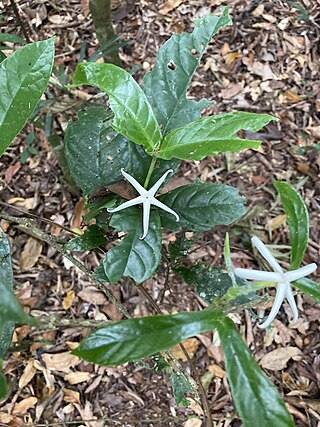
Adansonia perrieri, or Perrier's baobab, is a critically endangered species of deciduous tree, in the genus Adansonia. This species is endemic to northern Madagascar. It has been documented in only 10 locations, including the Ankarana, Ampasindava, Loky Manambato and Montagne d'Ambre protected areas. Most populations, however, are outside of protected areas. Each location has few individuals. With an estimated population of fewer than 250 mature individuals and ongoing habitat decline due to fire and cutting for charcoal and timber or clearing for mining, this species has been assessed by IUCN as Critically Endangered. There are three species of baobab found in northern Madagascar, all sharing the common name "bozy".

Atractocarpus chartaceus, commonly known as the narrow-leaved gardenia, is a species of evergreen flowering plant in the coffee family Rubiaceae. It is found in subtropical rainforest of eastern Queensland, Australia, and it is cultivated for its fragrant flowers and colourful fruit.

Atractocarpus fitzalanii, commonly known as the brown gardenia or yellow mangosteen, is a species of plant in the coffee and madder family Rubiaceae. It is found in coastal parts of tropical Queensland, Australia. The beautifully scented flowers and glossy foliage has seen this plant enter cultivation in gardens of eastern Australia.

Atractocarpus benthamianus is a species of flowering plant in the family Rubiaceae growing in eastern Australia, commonly known as native gardenia. It is an understorey species of subtropical and tropical rainforest on fertile soils. The natural range of distribution is from Forster, New South Wales to central Queensland. This plant features beautifully scented flowers.

Kailarsenia is a genus of flowering plants in the tribe Gardenieae of the family Rubiaceae. Its native range is Indo-China to West Malesia.

Larsenaikia is a genus of flowering plants in the tribe Gardenieae of the family Rubiaceae. Its native range is Eastern and Northern Australia.

Gardenia actinocarpa is a rare and endangered plant in the coffee and gardenia family Rubiaceae, native to a very restricted area within the Wet Tropics rainforest of northeastern Queensland.

Atractocarpus hirtus, commonly known as the hairy gardenia or native loquat, is a plant in the coffee family Rubiaceae, a large family of some 6,500 species with a cosmopolitan distribution. This species is endemic to northeastern Queensland, Australia.

Neostrearia is a monotypic genus - i.e. a genus containing only one species - of plants in the witch-hazel family Hamamelidaceae. It is the second described of three monotypic Australian genera in this family, the others being Ostrearia and Noahdendron. It is most closely related to these genera, as well as Trichocladus from southern Africa and Dicoryphe from Madagascar, and together these five genera form a distinct clade within Hamamelidaceae.
Christopher Francis Puttock, often cited as C.F.Puttock, is an Australian botanist and taxonomist who has interests in the Rubiaceae and Asteraceae flowering plant families as well as Pteridophyta (ferns) and Rhodophyta.

Noadendron is a monotypic genus - i.e. a genus containing only one species - of plants in the witch-hazel family Hamamelidaceae. It is the third described of three monotypic Australian genera in this family, the others being Ostrearia and Neostrearia. It is most closely related to these genera, as well as Trichocladus from southern Africa and Dicoryphe from Madagascar, and together these five genera form a distinct clade within Hamamelidaceae.

Mackinlaya macrosciadea, commonly known as mackinlaya or blue umbrella, is a plant in the carrot, fennel and parsley family Apiaceae, found in the Northern Territory and Queensland, Australia.

Atractocarpus merikin, commonly known as the mountain gardenia or merikin, is a plant in the Rubiaceae family endemic to northeast Queensland, Australia.

Cleistanthus apodus, commonly known as the weeping Cleistanthus, is a tree in the family Phyllanthaceae native to New Guinea and northeast Queensland. It was first described in 1873 by the English botanist George Bentham in his seven-volume book Flora Australiensis.

Fagraea fagraeacea, commonly known as yellowheart or pink jitta, is a plant in the gentian family Gentianaceae which is native to New Guinea and Queensland.

Atractocarpus sessilis, commonly known as brown randia, is an evergreen shrub in the family Rubiaceae. It is native to both Queensland, Australia, and Papua New Guinea (PNG).

Atractocarpus decorus is a plant in the coffee family Rubiaceae which is endemic to New Guinea. Like many others in the genus, it has glossy dark green leaves and attractive white flowers.

Debregeasia australis, commonly known as china grass or native ramie, is a plant in the nettle family Urticaceae endemic to Queensland, Australia.

Cupaniopsis foveolata, commonly known as narrow-leaved tuckeroo, white tamarind or toothed tuckeroo, is a plant in the maple and lychee family Sapindaceae found in eastern Queensland and New South Wales, Australia.

Astrotricha pterocarpa is a plant in the ivy family Araliaceae found only in tropical Queensland, Australia.

























